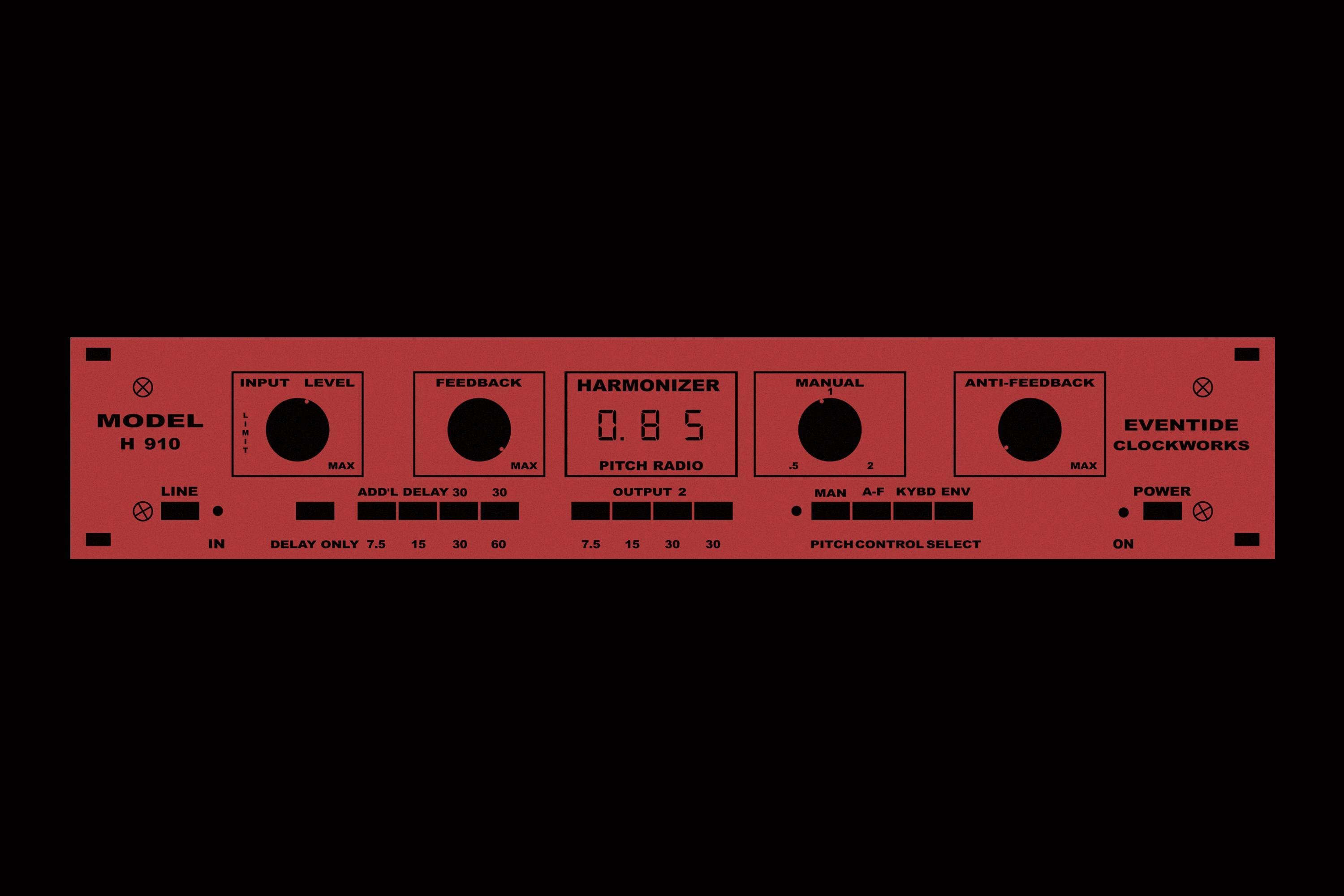More Songs About Painting and Food
Mike Rubin on a half-century of art and music commingling in New York City
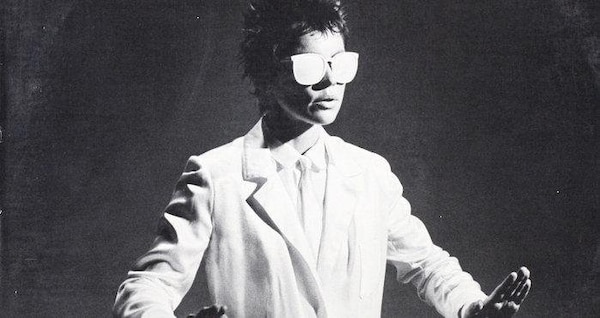
Earlier this year, on a March evening at Tribeca’s Clocktower Gallery, about 70 people stood around sipping complimentary glasses of wine. Artwork – including black-and-white photos by the singer Patti Smith – graced the walls, but the main attraction was the local premiere of “In Remembrance,” a performance and video installation by artist and musician Delia Gonzalez. Inspired by a Henry Miller text, Gonzalez had composed an electronic suite for herself and two keyboard collaborators.
Projected on the wall behind the trio was a 16mm film of leotard-wearing female ballet dancers pirouetting; though the footage had a washed-out, early ’80s video look, it actually dated from 2010 and was directed and choreographed by Gonzalez herself. The installation soundtrack will be released later this year as a box set on DFA Records, the New York label home to The Rapture and LCD Soundsystem, the latest fruit of the fertile crossover between New York’s art and music communities.
Integral components of the city’s cultural landscape, New York’s art and music scenes are often notoriously insular and balkanized. These rival worlds nevertheless occasionally combine in a synergistic, sometimes parasitic give-and-take that over the last half-century energized and inspired both communities, all while generating no small degree of exploitation and hype. “When you have a city that becomes the center of vanguard culture,” explains long-time gallerist and curator Jeffrey Deitch, “you have a convergence of innovation in visual art, dance, music, film, literature, and that happened in New York from the ’50s, ’60s, ’70s, ’80s and is still going on today. You very rarely have great achievement in visual art without parallel achievement in the other arts, and when the achievement is strongest there is a lot of convergence.”
The modern relationship between New York’s art and music circles began to flourish in the 1950s. After World War II, the rise of rhythm and blues, and then rock ’n’ roll, coupled with the rhythmic inscrutability of bebop, began to push jazz out of the mainstream of American music and toward the margins. As jazz moved sharply toward abstraction, like-minded artists in visual and verbal fields seemed to follow suit. The Beat movement rapidly became associated with jazz, as did abstract expressionist painters like Jackson Pollock, whose wife Lee Krasner once described him as often listening to his jazz records “day and night for three days running.... He thought it was the only other really creative thing that was happening in this country.”
In the early 1960s, the Fluxus movement fueled additional crossover. Arising out of Neo-Dadaism, Fluxus emphasized the mixing of media and the merging of artistic disciplines, which proved a boon to both experimental music and performance art, while Fluxus’ underlying principles of DIY, working with found objects, and anti-commercialism have remained present for decades in seemingly unrelated genres like punk, hip hop and electronic music.
No story of The Velvet Underground would be complete without mention of Andy Warhol.
When Welsh viola player John Cale first arrived in New York in the early ’60s, he eventually found his way to the Church Street loft of avant-garde composer and Fluxus collaborator La Monte Young (who had made a big splash locally by curating an influential series of 1960 concerts in conceptual artist Yoko Ono’s Chambers Street apartment). Young’s headquarters were frequented by minimalist sculptors Robert Morris and Walter De Maria, as well as musicians like Tony Conrad and Angus MacLise (a contributor to the Fluxus newspaper VTRE), who would join with Cale and Young in what would become The Theatre of Eternal Music. Young’s experiments in discordant drone would also become a crucial element of Cale’s next group, The Velvet Underground.
Of course, no story of The Velvet Underground would be complete without mention of Andy Warhol. Though Warhol had been designing album-cover art since 1949, it wasn’t until around 1963 that he began to directly manifest his interest in music, occasionally singing backup vocals along with artist Lucas Samaras in a band called The Druds that featured Young on saxophone, De Maria on drums, painter Larry Poons on guitar, and artist and poet Patty Mucha (then married to sculptor Claes Oldenburg) on lead vocals, singing lyrics written by painter Jasper Johns. Warhol also filmed The Fugs and The Holy Modal Rounders in 1965, before experimental filmmaker Barbara Rubin turned him on to The Velvets in December of that year. (Author J. Hoberman described Rubin, who also introduced Warhol to Edie Sedgwick, and Allen Ginsberg to Bob Dylan, as “an aesthetic shadkhn” – Yiddish for “marriage broker”).
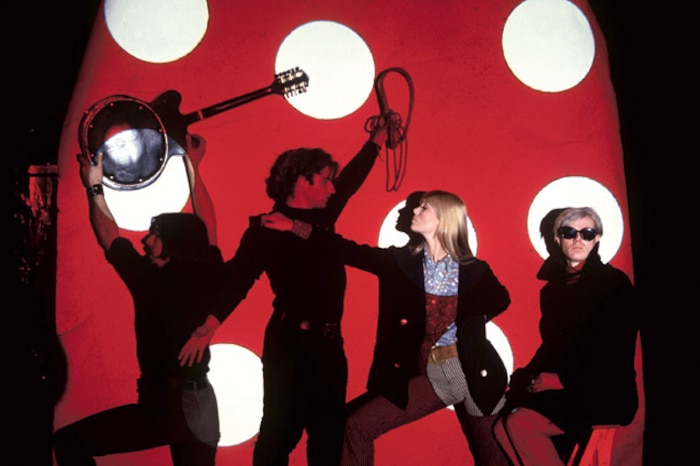
Warhol signed on as The Velvet Underground’s manager, added the German singer and model Nico as eye candy, and placed them at the center of a multimedia happening called The Exploding Plastic Inevitable, which featured the band playing live alongside strobe lights, a psychedelic slide show, film projections and dancers with whips. Inaugurated with a series of April 1966 events, The Exploding Plastic Inevitable’s total derangement of the senses grew out of the anarchic spirit of filmmakers like Rubin, Jonas Mekas, Jack Smith and Piero Heliczer (whose 1965 film with The Velvets called Venus in Furs is now lost to history). “Everybody and their mother was filming something and projecting them on bed sheets and having music played, dancing around it – it was really a free for all,” says Cale. “It was kind of exciting from that point of view, because it was a little out of control, but a lot of work got done.”
I’d be beating the shit out of those drums, and I’d look up and see – urgh! – it was 50-year-olds, people who came to see a soup can.
True to its name, Warhol’s Factory was all about artistic production, but its output struggled to reach beyond the art world. The Velvets’ debut album – now considered among the most influential rock albums ever – was in reality a commercial flop. The band spent 1966 and early 1967 playing museums and cultural happenings, but all involved soon realized that the sphere of pop culture still dwarfed that of pop art. In Clinton Heylin’s From the Velvets to the Voidoids, Velvets’ drummer Moe Tucker recalled playing at a Philadelphia art show: “I’d be beating the shit out of those drums, and I’d look up and see – urgh! – it was 50-year-olds, people who came to see a soup can, and this is what they got.”
The Velvets and Warhol parted ways in spring 1967, but The Exploding Plastic Inevitable’s multidisciplinary circus cast the blueprint for the fashionable and fabulous social milieu of ’70s nightlife, as well as modern club culture. Artists began looking to music as a primary outlet for expression; one who did so, and thus helped paved the way for some of rock music’s most pioneering sonic breakthroughs, was Alan Vega. After studying painting in the late ’50s under Ad Reinhardt at Brooklyn College, Vega (born Boroch Alan Bermowitz) moved into light sculptures made from electronic debris, using the name Alan Suicide.
At one point part of a socialist group called The Art Workers’ Coalition, which once barricaded The Museum of Modern Art, Vega had his world rocked when he saw a 1969 gig by The Stooges (whose debut album had been produced by Cale). “It showed me you didn’t have to do static artworks, you could create situations, do something environmental,” Vega told Simon Reynolds in 2002. “That’s what got me moving more intensely in the direction of doing music. Compared with Iggy, whatever I was doing as an artist felt insignificant.”
Suicide began gigging as a duo in 1970, its performances centered around the repetitive, churning noise of Martin Rev’s primitive keyboard drones and Vega’s cathartic stage persona. The band moved from playing gigs at galleries to venues like the Mercer Arts Center, but their cacophonic electronics and confrontational theatrics antagonized audiences and club owners alike – for years, violent reactions to the band made steady local gigs scarce, and they couldn’t find a label to release their debut album until 1977 – but they ultimately had a vital influence on punk, synth pop, and industrial music. “I first knew about Alan through his sculpture, which was sort of the analog to what he was doing in music,” says Deitch. “I followed him over to Max’s Kansas City and CBGB to see him perform because I knew his artwork.” (In 2002, Deitch would exhibit Collision Drive, Vega’s first gallery show in more than 20 years, at his Deitch Projects).
By the late ’70s and early ’80s, it seemed as if there was barely a distinction between the art and music worlds in the scruffy downtown post-punk and no wave scenes.
Patti Smith detailed her lengthy soul mate/muse relationship with photographer Robert Mapplethorpe (who took the iconic cover photos for Smith’s Cale-produced debut Horses and Television’s Marquee Moon) in her best-selling book Just Kids, but her oft-cited equation “art plus electricity equals rock ’n’ roll” set the template for the mid- to late-’70s downtown explosion. Alums of New York’s School of Visual Arts populated the CBGB scene, including Blondie’s Chris Stein and Punk magazine founder John Holmstrom. Talking Heads, fresh from the Rhode Island School of Design, established the enduring stereotype of the art-school student matriculating to the New York music scene. (Returning the favor, Talking Heads commissioned a 1987 book, What the Songs Look Like: Contemporary Artists Interpret Talking Heads Songs, pairing Byrne’s lyrics with work by artists like Keith Haring, Jean-Michel Basquiat and Robert Longo).
By the late ’70s and early ’80s, it seemed as if there was barely a distinction between the art and music worlds in the scruffy downtown post-punk and no wave scenes. Doing double duty in bands were filmmakers like Jim Jarmusch (Del-Byzanteens) and James Nares (Contortions), painters like George Condo (the Girls and Hi Sheriffs of Blue) and Robert Longo (Menthol Wars and Rhys Chatham’s Guitar Trio), sculptor Nancy Arlen (Mars), photographer Barbara Ess (Y Pants and Static, with her boyfriend Glenn Branca), performance artist Robin Crutchfield (DNA), and street artist Al Diaz – half of the graffiti duo SAMO with Basquiat – who occasionally played percussion for Liquid Liquid.
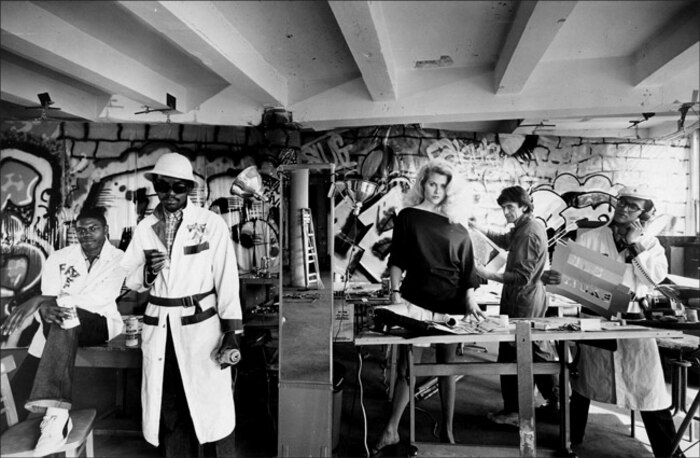
Then there was Basquiat himself. He was still known primarily for his SAMO graffiti when he attended the Canal Zone party in April 1979 that was organized by Michael Holman, Stan Peskett and Fab Five Freddy, the first meeting of downtown artists and uptown graffiti writers. Basquiat immediately proposed starting a band with Holman, and the two founded Gray, an experimental group where Basquiat coaxed bizarre sounds from a cheap synthesizer and played guitar with a steel file (a later iteration would include actor Vincent Gallo).
“The idea of being a fine artist and in a musical band, that was normal,” says Holman, who later became a filmmaker and visual artist and now teaches at New York’s School of Visual Arts. “Why not? Why would you do that? Because you can. Because you can be on stage and get chicks and look cool and realize your fantasy of being in a band and being a fine artist and a painter and dressing like Cab Calloway or Frank Sinatra in the ’60s and cutting your hair any crazy way you want and dancing all night to four in the morning at the Mudd Club and being a poet and being an actor in a film. Jean was an actor in a film, the leader of Gray, doing his SAMO graffiti, all at the same time. Why? Because we could. Because nobody was there to tell us we couldn’t do any of those things.”
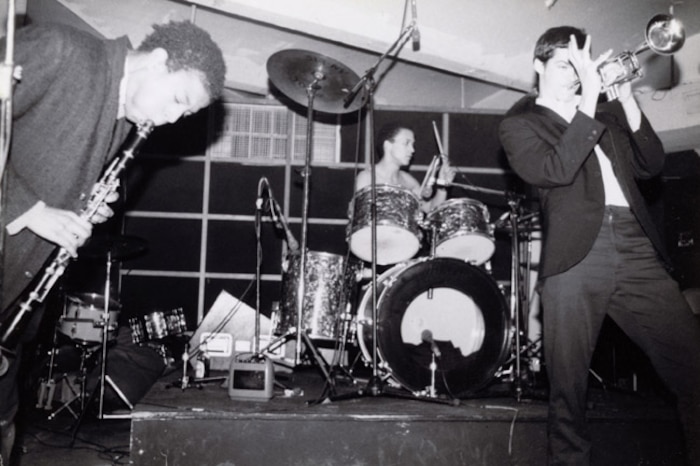
The air was suffused with a collaborative spirit as the ’80s dawned, abetted by cheap rents that gave artists and musicians the financial freedom to innovate. “A lot of these musicians that I met at the time often had training in art school and not so much in music,” says the artist and musician Christian Marclay. “This was a different art world. It wasn’t so commercial as it is now, so people felt more freedom in doing performance because regardless, there was no money to be made either way – if you made paintings or objects they weren’t going to sell – so you might as well have fun and just make some music. We were all in New York to make interesting art and, not compete with each other, but just kind of experiment together.”
As a visual artist interested in performance art, the leap from performance art to punk seemed to me an obvious thing.
In 1981, performance artist Laurie Anderson scored an unlikely hit on the UK charts with “O Superman,” landing her a seven-album deal with Warner Bros. and putting performance art on the musical map. In Marclay’s view however, the relationship between the two disciplines had already borne fruit. “As a visual artist interested in performance art,” says Marclay, “The leap from performance art to punk seemed to me an obvious thing. Punk was so much about a kind of performance – it was visual... Very theatrical in a weird way, so I always thought there was a connection between the two.”
For a while in downtown circles the term “art music” became synonymous with noise, thanks in large part to the efforts of Sonic Youth, who built upon the atonal dissonance of La Monte Young and no wave’s deconstructed punk, adding their own unconventional guitar tunings. Kim Gordon was an Otis Art Institute graduate, painter, Artforum writer, and gallery curator, while Thurston Moore organized the nine-day Noise Fest in June 1981 at the Soho gallery White Columns that established Sonic Youth as key figures in the downtown scene.
Artists didn’t just get off on heady noise, but also on the body music permeating the city’s discos. Keith Haring, who rose rapidly from making subway chalk drawings to become one of the era’s most iconic visual stylists, drew inspiration from the proto-house music he heard at the Paradise Garage. Haring became friends with the Garage’s groundbreaking DJ Larry Levan, and his murals would ultimately decorate the club. “I don’t know if you know how important the Paradise Garage is, at least for me and the tribe of people who have shared many a collective spiritual experience there,” Haring wrote in a July 1986 letter to Timothy Leary. “I can’t explain exactly why, but something about just knowing it was there was a comfort, especially when I was out of New York City. There was always something to look forward to immediately upon my return... It really was kind of a family. A tribe.”
Graffiti-bombed subway cars and buildings also stoked the city’s creative fires. Documented by filmmaker Charlie Ahearn and photographers like Henry Chalfant and Martha Cooper, graffiti artists were nearly as central to early hip hop as the rappers themselves; initially viewed as vandalism, graffiti is now celebrated as one of hip hop culture’s five essential elements.
Fab 5 Freddy was perhaps the key figure in bringing graffiti art from the streets and subway yards into the galleries.
Fab 5 Freddy (born Fred Braithwaite) was perhaps the key figure in bringing graffiti art from the streets and subway yards into the galleries. The Brooklyn native aspired to be a serious artist, and had studied enough art history – he painted Warhol’s soup can on the side of a train – to be aware of both graffiti’s radical aesthetic and the downtown art scene that might be ready to embrace it. Besides planning the watershed Canal Zone party with Holman and Peskett, Freddy co-curated the Mudd Club’s “Beyond Words” graffiti art show in April 1981 with artist Futura 2000, and is credited with bringing South Bronx personas like Afrika Bambaataa and Lee Quiñones their first downtown acclaim. A hustler in the best sense of the word, Freddy also released a rap 12-inch (1982’s “Change the Beat,” with his line “Ahhhhh, this stuff is really fresh,” sampled in Herbie Hancock’s seminal 1983 scratch single “Rockit”), appeared in films like Ahearn’s 1983 Wild Style, and in 1988 became the host of the influential hip hop video show Yo! MTV Raps.
Soon music wasn’t merely a meeting ground, but a subject matter of the art itself. Marclay turned the vinyl record into a form of material, whether making sound bricolage via multiple-turntable performances (later expounded upon by hip hop turntablism), collaging fragments of albums and cover sleeves into sculptural objects he called “Recycled Records,” or fashioning turntables into new instruments like the “Phonoguitar” and “Phonodrum.”
Conceptual artist Dan Graham, Thurston Moore’s upstairs neighbor, created Rock My Religion in 1983, a 55-minute video essay (which included footage of a Black Flag gig and music by Sonic Youth and Glenn Branca) that placed performers like Patti Smith on a spiritual continuum stretching back to Ann Lee, the founder of the Shakers religious movement. In Graham’s closing argument he proposed, “In the 1970s the religion of the ’50s teenager and the ’60s ‘counterculture’ is adopted by pop artists who propose the end of the religion of ‘art for art’s sake.’ Patti Smith took this one step further: she saw rock as an art form which could come to replace poetry, painting and sculpture. If art is only a business, as Warhol suggests, then music expresses a more communal, transcendental emotion which art now denies.”
AIDS was devastating to the scene in the ’80s and early ’90s... So there was a period in the ’90s where there wasn’t as much connection between the performance and music sides and the visual-art side.
But just as the cultural cross-pollination was reaching full bloom, it withered and died. Among those claimed by the AIDS epidemic were Mapplethorpe, Haring and Arthur Russell, an avant-garde cellist and composer who straddled the worlds of The Kitchen and The Paradise Garage, creating some of the most forward-thinking dance music ever. “AIDS was devastating to the scene in the ’80s and early ’90s,” says Deitch, “because a lot of the mixers – the people who put it all together, the club entrepreneurs, writers – a lot of them were lost to AIDS, and the community was devastated. So there was a period in the ’90s where there wasn’t as much connection between the performance and music sides and the visual-art side.”
In the late ’90s, signs of life began to reappear. In 1999, Gavin Brown (the dealer for painter Elizabeth Peyton, who had gained attention making small-scale portraits of musicians like Kurt Cobain) opened a bar, Passerby, attached to his Chelsea gallery. The watering hole, complete with artist Piotr Uklanski’s flashing disco-light floor, quickly became a mecca for art-world and music scenesters alike. James Murphy and Jonathan Galkin met for the first time at Passerby – “That night changed my life forever,” recalls Galkin – and soon the pair not only launched DFA Records together, but returned to Passerby to present events like Delia Gonzalez and Gavin Russom’s debut DFA performance. “James Fuentes, a curator, helped us stage a beautiful live show there behind banks of old TVs,” says Galkin. “We utilized an Atari 1970s video music interface. It was fantastic.”
Deitch also helped connect the cultural dots at his two Soho art spaces. “Most galleries are really focused on a more narrow mission,” said Deitch, “But we began opening up the gallery as a platform for this new convergence which characterized the 2000s and was a very exciting time for me.”

The most infamous figures of the new convergence were the members of performance-art troupe Fischerspooner, which Deitch describes as “an ongoing project about entertainment and spectacle.” The group’s May 2002 showcases at Deitch’s Wooster Street space were typically over-the-top; it was Pet Shop Boys meets Showgirls, a campy big-budget spectacular with dozens of performers, smoke machines, mullet wigs, Mad Max costumes and all the pomp – and pomposity – of a Broadway musical, albeit with an Off-Off-Broadway bent.
Deitch and DFA’s Murphy met at a Fischerspooner performance, which led to collaborative events between the gallery and label at Art Basel in Miami Beach. (Murphy will also be co-curating an upcoming show on disco at Deitch’s current institution, the Museum of Contemporary Art in Los Angeles.) DFA’s roster has been home to Black Dice (whose members have included visual artists Bjorn Copeland and Hisham Bharoocha) and Gonzalez and Russom, who also crafted sculptural objects in addition to their performance work. Since their partnership ended in 2005, Russom now leads The Crystal Ark, whose live shows look like what might have happened if Warhol’s Exploding Plastic Inevitable had been realized instead by filmmaker Jack Smith: the stage bursting with musicians, pulsing psychedelic visuals, campy costumes, and a polymorphous panoply of exotic dancers.
Music has continued to expand the art world’s reach, and curators are well aware that a younger demographic offers a potentially renewable energy source.
Today, every major New York museum also doubles as a de facto nightclub and performance space, from Kraftwerk selling out a week of shows at MoMA last year to Liars playing the Metropolitan Museum of Art’s Temple of Dendur this month. MoMA PS1 in Queens has devoted particular attention to musical programming. Both its performance-oriented Sunday Sessions and weekly summer Warm Up series draw enormous crowds of younger audiences, who might even pause to check out the galleries in between checking out each other.
Not everything works, of course. The Brooklyn Museum’s monthly dance party Target First Saturdays was so popular it had to be canceled in October 2012 after crowds swelled to more than 20,000, overwhelming museum staff. The same month, the fusty ol’ Met tried to youthanize its database by hiring DJ Spooky as its first-ever artist-in-residence (a job the Twitterati quickly dubbed “relevance guru”), not realizing that his license to illbient had long since expired.
But hiccups aside, music has continued to expand the art world’s reach, and curators are well aware that a younger demographic offers a potentially renewable energy source. “I think it’s the marketplace that continues to divide things up into these distinctions and say this is art and this is music,” says Russom. “It’s just basically how things get sold. As far as I can tell, that’s the only thing that makes them really different.” The real difference, of course, is that at a New York club, a glass of wine will cost you dearly. At an art gallery’s opening reception, as any culture vulture can tell you, the drinks are always free.
A version of this article appeared in The Daily Note, a free daily newspaper distributed in New York during the 2013 Red Bull Music Academy.
Header image © Big Science album cover
